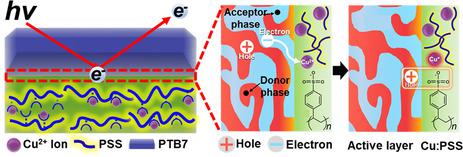Our official English website, www.x-mol.net, welcomes your feedback! (Note: you will need to create a separate account there.)
A pH-Neutral Polyelectrolyte Hole Transport Layer for Improved Energy Band Structure at the Anode/PTB7 Junction and Improved Solar Cell Performance
Solar RRL ( IF 7.9 ) Pub Date : 2021-09-12 , DOI: 10.1002/solr.202100521 Ju Hwan Kang 1 , Amit Kumar Harit 2 , Ji-Eun Jeong 2 , Han Young Woo 2 , Jung Hwa Seo 1, 3 , Bright Walker 4
Solar RRL ( IF 7.9 ) Pub Date : 2021-09-12 , DOI: 10.1002/solr.202100521 Ju Hwan Kang 1 , Amit Kumar Harit 2 , Ji-Eun Jeong 2 , Han Young Woo 2 , Jung Hwa Seo 1, 3 , Bright Walker 4
Affiliation

|
In organic solar cells (OSCs), interfacial properties between the donor phase and hole transport layers (HTLs) are critical factors which govern charge extraction efficiency. Many ionic and polar materials are known to function as effective interfacial layers; however, an understanding of how ionic moieties affect the electronic band structure and characteristics of OSCs is lacking. Herein, a new, pH-neutral polyelectrolyte is introduced that resolves several problems which are encountered with the commonly used HTL, poly(3,4-ethylenedioxythiopene):polystyrenesulfonate (PEDOT:PSS). An effective p-type polyelectrolyte dopant is designed, comprising an anionically charged PSS backbone with easily reduced Cu2+ counterions (Cu:PSS), and interfacial properties for HTL/donor interfaces by photoelectron spectroscopy are analyzed. The effects of the polyelectrolyte on interfacial energy levels and charge extraction efficiency between the active layer and HTL are quantified. Using optimized processing conditions, the efficiency can be improved from 8.31% to 9.28% in conventional OSCs compared with a standard PEDOT:PSS HTL. The energy-level alignment at the HTLs/donor interface determined by UV photoelectron spectroscopy measurements reveals the origin of distinct differences in device performances. The reduced ionization potential (IP) and hole injections barrier (Φh) at the HTL/donor interface play a crucial role in efficient charge extraction in conventional OSCs.
中文翻译:

用于改进阳极/PTB7 结的能带结构和改进太阳能电池性能的 pH 中性聚电解质空穴传输层
在有机太阳能电池 (OSC) 中,施主相和空穴传输层 (HTL) 之间的界面特性是控制电荷提取效率的关键因素。已知许多离子和极性材料可用作有效的界面层;然而,缺乏对离子部分如何影响 OSC 的电子能带结构和特性的理解。本文介绍了一种新的 pH 中性聚电解质,它解决了常用 HTL 遇到的几个问题,聚(3,4-亚乙基二氧噻吩):聚苯乙烯磺酸盐(PEDOT:PSS)。设计了一种有效的 p 型聚电解质掺杂剂,包括带阴离子电荷的 PSS 主链和容易还原的 Cu 2+反离子 (Cu:PSS),以及通过光电子能谱分析 HTL/供体界面的界面特性。聚电解质对活性层和 HTL 之间的界面能级和电荷提取效率的影响被量化。使用优化的加工条件,与标准 PEDOT:PSS HTL 相比,传统 OSC 的效率可以从 8.31% 提高到 9.28%。由紫外光电子能谱测量确定的 HTL/供体界面的能级排列揭示了器件性能明显差异的起源。HTL/供体界面处降低的电离电位 (IP) 和空穴注入势垒 (Φ h ) 在传统 OSC 的有效电荷提取中起着至关重要的作用。
更新日期:2021-11-04
中文翻译:

用于改进阳极/PTB7 结的能带结构和改进太阳能电池性能的 pH 中性聚电解质空穴传输层
在有机太阳能电池 (OSC) 中,施主相和空穴传输层 (HTL) 之间的界面特性是控制电荷提取效率的关键因素。已知许多离子和极性材料可用作有效的界面层;然而,缺乏对离子部分如何影响 OSC 的电子能带结构和特性的理解。本文介绍了一种新的 pH 中性聚电解质,它解决了常用 HTL 遇到的几个问题,聚(3,4-亚乙基二氧噻吩):聚苯乙烯磺酸盐(PEDOT:PSS)。设计了一种有效的 p 型聚电解质掺杂剂,包括带阴离子电荷的 PSS 主链和容易还原的 Cu 2+反离子 (Cu:PSS),以及通过光电子能谱分析 HTL/供体界面的界面特性。聚电解质对活性层和 HTL 之间的界面能级和电荷提取效率的影响被量化。使用优化的加工条件,与标准 PEDOT:PSS HTL 相比,传统 OSC 的效率可以从 8.31% 提高到 9.28%。由紫外光电子能谱测量确定的 HTL/供体界面的能级排列揭示了器件性能明显差异的起源。HTL/供体界面处降低的电离电位 (IP) 和空穴注入势垒 (Φ h ) 在传统 OSC 的有效电荷提取中起着至关重要的作用。



























 京公网安备 11010802027423号
京公网安备 11010802027423号